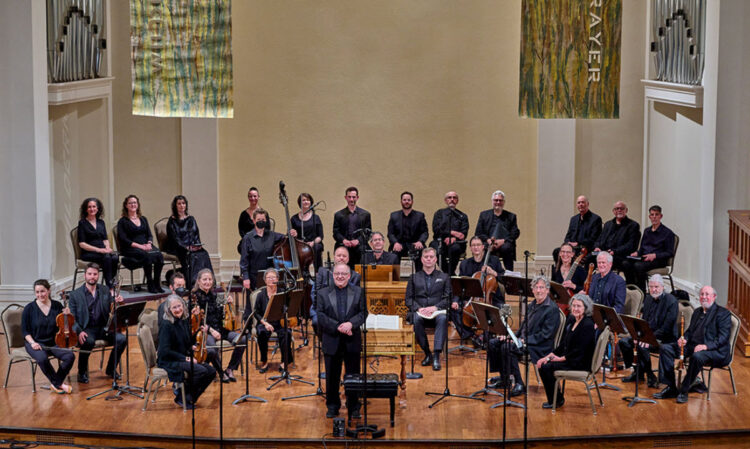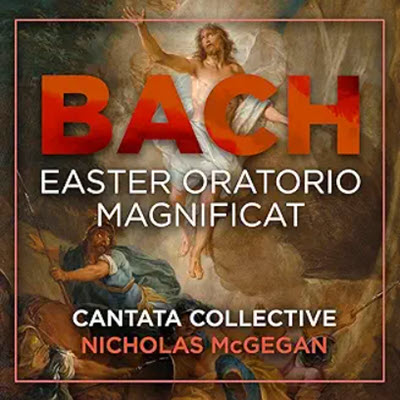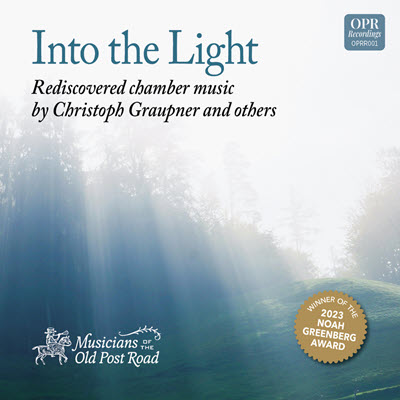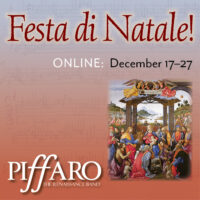by Jeffrey Baxter
Published April 18, 2025
J.S Bach: Easter Oratorio and Magnificat. Cantata Collective Orchestra and Chorus, soprano Nola Richardson, countertenor Aryeh Nussbaum Cohen, tenor Thomas Cooley, baritone Harrison Hintzsche, conducted by Nicholas McGegan. AVIE Records AV2756

In their fifth installment of a recording initiative begun in 2020, Nicholas McGegan and the Bay Area’s Cantata Collective continue the journey of traversing Bach’s masterworks with this performance of the Easter Oratorio, BWV 249, and the D-Major Magnificat, BWV 243.2. Both are of the dramatic/narrative Oratorio-type works (unlike Bach’s weekly reflective/poetic cantata model) and employ a very similar “festive” orchestra, expanded for special occasions like Easter and other holy days.
The Easter Oratorio began life as a birthday ode to the nobleman patron, Christian, Duke of Saxe-Weissenfels, and represents one of Bach’s many instances of “up-cycling” his own pre-existing music for later needs. Nicholas McGegan points out in the liner notes that in addition to music from the birthday ode, the Easter Oratorio’s first three movements likely come from an instrumental work from Bach’s time in Köthen.

There is no narrator, as in the Passions or the Christmas Oratorio, but, instead, four soloists take the roles of Mary Jacobi (soprano), Mary Magdalene (alto), and the two apostles Peter (tenor) and John (bass).
The brilliant two-section Sinfonia begins with an opening allegro in 3/8 to which conductor McGegan has cleverly applied concerto grosso principles of using a solo violin pitted against the tutti strings in sections that veer from the home key of D Major.
The following adagio in 3/4 is crafted in a French sarabande style, with a series of dotted rhythms (and silences) that accompany an achingly beautiful oboe line, floating high above — deftly dispatched by Marc Schachman — in perhaps a depiction of the sorrow and weeping before the discovery of the empty tomb.
The opening chorus, “Kommt, eilet und laufet,” with its tenor and bass duet devised by Bach for the movement’s B section, shows the Cantata Collective’s Chorus at full strength, where they deliver the four-part writing clearly, both in independent lines and in the strongly declaimed cadences of “Erreichet die Höhle, die Jesum bedeck!”
Soprano Nola Richardson’s flute-like vocal quality lends an elegant sensitivity to text and legato-line in the aria “Seele, deine Spezereien.” She is equally matched by Sandra Miller’s soaring flute obbligato.
In the tenor aria of comfort and peace, “Sanfte soll mein Todeskummer,” with its gentle rocking motion and calming character, one hears Bach similar approaches of coming to peaceful terms with mortality (as he evoked in the aria from BWV 82, “Schlummert ein,” or the Matthew Passion’s bass aria “Mache dich, mein Herze rein,” and the solo alto cantata, BWV 170, “Vergnügte Ruh”). It is in this aria that some of the best singing on the recording may heard. Tenor Thomas Cooley delivers a devastatingly beautiful and passionate delivery of text, fullness of tone in all registers, and undisturbed legato line. His hushed pianissimo at the da capo seems to make time stand still, in breathless awe and unimaginable serenity. His intonation is flawless (unlike, unfortunately, the two recorder players who seem to play below pitch almost throughout). This artistry is all the more impressive, knowing of Cooley’s openly discussed challenges of singing with hearing loss, as he described in these pages in 2024.
Tenor Thomas Cooley’s hushed pianissimo at the da capo seems to make time stand still, in breathless awe and unimaginable serenity.
The urgency of anticipation is evoked in the aria, “Saget, saget mir geschwinde,” where alto and oboe d’amore chase one another in rolling roulades of 16th notes. Countertenor Aryeh Nussbaum Cohen sings with an impressive security and character, especially in the sudden dramatic shift to adagio near the end of the A section, to highlight the text, “Ganz verwaiset und betrübt.”
The closing chorus, “Preis und Dank,” an ingenious combination of a gigue layered onto a gavotte, is confidently delivered by Cantata Collective’s Chorus in bold declamation and clear lines. Their joyful outbursts that flow from this music undoubtedly stem from their responses to the secure and engaging leadership from the podium. Their best efforts in the Easter Oratorio, however, are met with challenges in the numbers that seem to be stacked against them in the Magnificat. (The decimal addition in the latter’s BWV number, 243.2, signifies it is Bach’s version without Christmas hymns.)
For these performances, Nicholas McGegan assembled an orchestra of ten strings [3-3-2-1-1], with solo winds, brass, timpani, and organ. They are supplemented by a chorus of 15 singers, divided three-to-a-part for the Magnificat’s five-voice SSATB choruses [3-3-3-3-3], and four-ways SATB [5-4-3-3] for the Easter Oratorio.
Most scholars agree — including esteemed Bach-guru Christoph Wolff — that a chorus of 15 to 20 singers is roughly what Bach would have expected to hear for his “festively” orchestrated large works for chorus, like the B-minor Mass and Magnificat. He specified this in his famous “Entwurff” (Memorandum) to the Leipzig town council in 1730.
In this light, McGegan and his forces are spot-on numerically and represent an accurate and elegant account of each score on this recording. It is only a pity that in some important tutti moments — like the Magnificat’s “Fecit potentiam” and its homophonic forte ending, “mente cordis sui,” as well as the explosive “Omnes generationes” and “Gloria Patri” — the energy of a dramatic punch that a few more voices could provide is lacking.
The combined vocal resources seem pale, leaving the performance to rely on the force of the doubling instruments. Perhaps Bach, in his practical experience in Leipzig, anticipated this and accounted for it by his skillful orchestration, but to modern ears it can sound disappointing. Instead, one looks to other fine examples, such as John Eliot Gardiner’s Monteverdi Choir in their prime or Raphaël Pichon’s excellent Pygmalion ensemble (whose recent B-minor Mass recording employs a chorus of 30).
That said, some excellent music-making may be found in this Magnificat. Soprano Nola Richardson, while struggling to project the lower register required for the Magnificat’s “Et exultavit,” shines in the glorious suspended lines of “Quia respexit,” shared with oboist Marc Schachman who also excels in the solo trio “Suscepit Israel.”
Baritone Harrison Hintzsche nicely handles the lower bass extremes called for in “Quia fecit mihi magna” and gives a convincing reading, supported by the creative continuo-realization of organist Hanneke van Proosdij. Countertenor Cohen and tenor Cooley sing as one in the sensitively delivered duet, “Et misericordia.”
Jeffrey Baxter is a retired choral administrator of the Atlanta Symphony Orchestra, where he managed and sang in its all-volunteer chorus and was an assistant to Robert Shaw. He holds a doctorate in choral music from The College-Conservatory of Music of the University of Cincinnati and has written for BACH – The Journal of the Riemenschneider Bach Institute, The Choral Journal, and ArtsATL. For Early Music America, he recently reviewed John Weldon’s prize-winning The Judgment of Paris.




